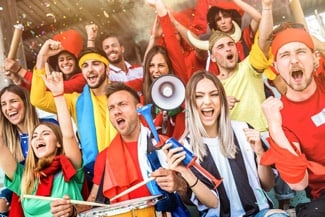How does a soccer fan's brain work?
 With the FIFA World Cup taking place in Russia, we thought it was an appropriate time to take a look at this study published in Scientific Report in November 2017. Whether you’re a soccer fanatic or not, discover what happens in the brain of a soccer fan who feels they're part of a group, a family. What sorts of altruist behavior do they show?
With the FIFA World Cup taking place in Russia, we thought it was an appropriate time to take a look at this study published in Scientific Report in November 2017. Whether you’re a soccer fanatic or not, discover what happens in the brain of a soccer fan who feels they're part of a group, a family. What sorts of altruist behavior do they show?Belonging to a group is considered to be a basic human need. Research has shown that humans have a tendency to favor their ingroup, or the group to which one belongs. In this area, soccer fans provide extraordinary research subjects. Their behaviors show their strong attachment to the group, their real and constant solidarity. But the neural foundations underlying this attachment and within-group altruism have received little attention from research. This is exactly what French, English, German, and Brazilian researchers aimed to do.
Specifically, the team from D’Or Institute for Research and Education in Rio de Janeiro recruited 27 fans (all men, average age = 28 years) from the city's main soccer teams: Botafogo, Vasco de Gama, Fluminense and Flamengo. The researchers subjected the participants to a test motivated by a monetary prize while recording their brain activity using functional magnetic imaging (fMRI). Once seated, each participant had to squeeze the electronic handgrip of a dynamometer. The harder they squeezed, the more money they received. The fans were given three options: in the first, the participant himself received the money, in the second the sum was distributed among other fans of his club, and in the third, the money went to anonymous recipients who weren’t fans of any of the clubs. Using a physical task, these “self," “fan,” and “non-fan” conditions allowed the researchers to evaluate motivation associated with personal gain, as well as ingroup and outgroup altruism.
The experimental results indicate that when the participants were trying to earn money for friendly fans, they were able to squeeze the handle more firmly than when the sum was intended for an anonymous group. But the effect was even stronger when they were promised the money for themselves. While we may be capable of showing selflessness, we still tend to put in more effort if we get to keep the prize ourselves! These results aren’t terribly surprising. But the real interest of this study lies in the observations made on a neuronal level. Indeed, while the experiment elicited activity in the medial orbitofrontal cortex in the three conditions, stronger connections were observed between this area and the anterior cingulate cortex when the participants were trying to earn money for a fan of the same team. The latter of these brain areas is involved in altruistic decision-making and group and particularly family affiliation. In soccer fans, this increased functional connectivity observed between these two brain areas illustrates the links that unite fans of the same team.
At the end of their study, the neuroscientists indicated that, given the behavior differences between men and women in an (endo)group, it would be interesting to compare the results of women using the same motivational experiment to earn money for their “peers.” Female soccer fans beware!
Source: T. Bortolini, P. Bado, S. Hoefle, A. Engel, R. Zahn, R. de Oliveira Souza, J.C. Dreher, J. Moll, Neural bases of ingroup altruistic motivation in soccer fans, in Scientific Reports, Nov. 2017







